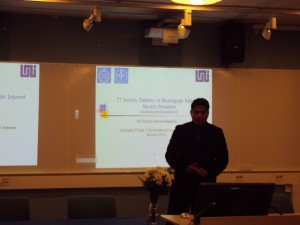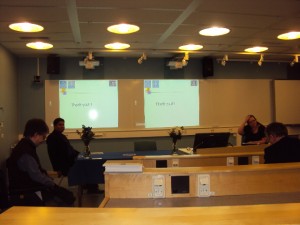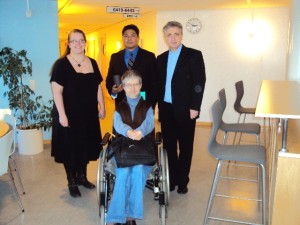For those interested in the presentation named “The effect of Critical Success Factors on IT governance performance in public sector organizations in a developing country” that took place on February 2, 2011 in the Open IS-seminar please access the following file: CSFs effect on IT Governance Performance – 2011-02-02
Johnny Flores’s Licentiate Seminar
On January 31, 2011 our colleague Johnny Flores has defended successfully his Licentiate Thesis named: “IT Service Delivery in Nicaraguan Internet Service Providers: Analysis and Assessment”. On behalf of research group in IT Management I would like to congratulate Johnny for his achievement. Some pictures from the seminar and after the seminar are included below.
Paper published in International Journal of Information Technology and Management
A paper named “Assessing the Risk Exposure in IT Outsourcing for Large Companies“ and written together with Georg Hodosi has been published in International Journal of Information Technology and Management, Vol. 10, No. 1, pp. 24-44, 2011. The paper is presenting the design of an information technology outsourcing (ITO) tool that includes a procedure based on transaction cost theory for assessing the risk exposure in ITO. The ITO tool presented in this paper is a useful and effective instrument for the IT decision-makers in support of decisions to outsource IT or not. In the development of the ITO tool, we have approached two large companies in Sweden with more than 20 years experiences in ITO that have helped us in the improvement and evaluation of the usability and effectiveness of this tool. For more information about this paper please access the following link: http://www.inderscience.com/search/index.php?action=record&rec_id=37760&prevQuery=&ps=10&m=or
Seminar on “IT Management Research in DSV: Quo Vadis?”
On November 2, 2010 I have made a presentation in the seminar with senior researchers’ from our department (DSV) concerning “IT Management Research in DSV: Quo Vadis?”. My presentation has approached the main concepts in IT Management and the importance of research in this area, the trends in IT Management and research performed by IT Management group till now in IT Management area. Finally I have presented the results of IT Management research from 2007 (the year when the IT Management group has started his activity) till now and the research plan for the next year. In case you are interested in my presentation please have a look on the attached file: IT Management Research in DSV – 2010-11-02.pdf
Collaboration with IBM in Global IT Management course and in co-supervision of master theses in different topics of IT Management
The Global IT Management (GITM) course is in my opinion one of the important courses that together with Strategic Management of IT course needs to be part of a master program in information systems/information technology. In 2003 I have designed the Global IT Management course (7.5 ECTS) that has run for the first time in 2004 in the master programs in Internetworking and Engineering and Management of Information Systems at KTH. The GITM course is one that is looking to enhance students’ knowledge in information and communications technologies (ICT) support in globalization and companies that operates in a global business environment. In 2004 I had 72 students enrolled in the Global IT Management course and in the next years the students’ number have continue to increase. Now in 2010 I have 86 students enrolled in GITM course that are coming from different master programs at KTH and Stockholm University plus exchange students.
From the experience of former students in Global IT Management course we have found that for most of them this course was an opportunity and challenge to enhance their knowledge in the IT Management area and develop new skills about how to deal with different cultures by working in multicultural teams. As a result many students have mentioned me that the GITM course have been a usefully experience for them. In GITM course the students are doing team projects using as case studies different global companies. The team project is an important assessment component in this course and in 2008 I have performed a research about the contribution of the team project on students’ learning in GITM course. In case you are interested in the results of this research please read my paper published in Springer Communications in Computer and Information Science, 2010, Volume 111, 28-40, http://www.springerlink.com/content/jq774062hn586554/
During the last 7 years I have continuous improved the GITM course in his content and organization. I have also tried in all these years to bring different guest speakers from IT industry in GITM course in order to share their experience with my students. As a result of the positive impact that this course has had in enhancing students’ knowledge in IT Management a former KTH student Robin Zimmermann (who has worked at IBM Sweden and now he is working at Accenture) has offered me the opportunity to establish a collaboration with IT professionals from IBM. The colaboration with IBM will consists in guest lectures offered in GITM course 2010 and in co-supervision of master theses in different topics of IT Management. Furthermore I hope that the present collaboration with IBM will be extended also for the Strategic Management of IT course given in Spring 2011.
In case you are having an interest in the content of the lectures given by IT professionals from IBM in Global IT Management course 2010 you are welcome for attending them. The dates, hours and topics of the lectures are following below.
2010-11-08, 9.00 – 9.45, Sal B, Forum, Abhishek Sinha (IBM India), Lecture: Organizing IT
2010-11-15, 14.00 -14.45, Sal A, Forum, Abhishek Sinha (IBM India), Lecture: IT strategy
2010-11-17, 9.00 – 9.45, Sal B, Forum, Abhishek Sinha (IBM India), Lecture: Outsourcing and Offshoring of IT
2010-11-19, 14.00 – 14.45, Sal B, Forum, Jan Pettersson (IBM Sweden), Lecture: IBM Global Solution Architecture Repository
The Swedish Research School of Management and IT (MIT) – seminar at Uppsala University
As members of The Swedish Research School of Management and IT (MIT) Edephonce Nfuka and I have participated between 5 to 7th October 2010 to the MIT seminar at Uppsala University. Here we have presented a research paper named “The effect of critical success factors on IT governance performance in the public sector organizations from a developing country: A case of Tanzania”. The paper has well been received and the comments we have got from the participants to this seminar will due to an improvement of our paper that has been targeted to be submitted for publication to a journal. The MIT seminar from this year was also an opportunity to attend different paper presentations and make constructive comments to the authors for the improvement of their papers. Moreover in the MIT seminar from Uppsala University we have attended three interesting lectures done by Professor John Kimberly from The Wharton School, University of Pennsylvania. For more information about The Swedish Research School of Management and IT (MIT) please access the following link: http://www.mit.uu.se/
Paper accepted for publication in Hawaii International Conference on System Sciences (HICSS-44) proceedings
A paper named “Organizational Culture Impact on Business-IT Alignment” written by Mohamed El Mekawy and me has been accepted for publication in the proceedings of Hawaii International Conference on System Sciences (HICSS-44) publisher IEEE Computer Society (http://www.hicss.hawaii.edu/hicss_44/apahome44.htm). The Hawaii International Conference on System Sciences (HICSS) is a top ranked conference and is ranked “A” according to The Australian Government’s Excellence in Research project (ERA) (http://lamp.infosys.deakin.edu.au/era/?page=cfordet&selfor=0806). Therefore we are very happy that our paper (that has received excellent reviews) has been accepted for publication in HICSS-44 conference proceedings. An abstract of our paper is following below.
Abstract.
Importance of Business-IT Alignment (BITA) has increased over the past few years. However, achieving and maturing BITA still has apparent difficulties. Therefore, research efforts resulted in a number of theoretical models that can be applied as supportive tools for assessing different components of BITA. Most of these efforts have been produced either in Anglo-Saxon Countries or based on their experiences. The purpose of this paper is to explore the impact of organizational culture on maturity of BITA. The paper relies on the nine dimensions of Project GLOBE to understand societal as well as organizational culture. It also relies on the bottom-up comprehensive approach of Luftman’s Strategic Alignment Maturity Model to understand organization’s alignment components. To fulfill the purpose of this study, a comparative analysis has been carried out between two subsidiaries of a multinational organization with a federal organizational structure that operates in Egypt and Sweden. The results shows that: a) is a difference in how different components of BITA are interpreted and implemented in different organizational culture, and b) that the impact of organizational culture on BITA maturity is more complex than what is expected especially on variables that require social interactions.
Paper published in the Information Systems Management journal
A research paper written together with Alexandru Smeu (a former student to which I have been the supervisor on his diploma thesis at Faculty of Business from Babes-Bolyai University Cluj-Napoca, Romania) has been published in the Information Systems Management journal, Volume 27, Issue 3, June 2010, pages 238-246. I am very happy about this result because Information Systems Management journal is a very good one among the journals in Computer Science/Information Systems area and is ranked by Thomson Reuters, having the impact factor 1.242.
The published paper is named “Managing the Reliable Design of an Enterprise IT Network Infrastructure “. The focus in this paper is on the practical modalities of designing a reliable IT network infrastructure in an enterprise. In this direction an algorithm has been developed that is a hybrid between classic greedy and simulated annealing that search for the most reliable IT network infrastructure meeting the imposed budget cost constraints and the enterprise managers’ decisions constraints. A key point of the proposed solution is the way in which the enterprise managers are involved in the estimation of the relative importance of their interconnections between their business’s data centers. Furthermore, the algorithm presented in this article has been evaluated in the case of a retail enterprise for addressing the business’s demands for a higher reliability of their IT network infrastructure.
For more information about this paper please access the following link:
http://www.informaworld.com/smpp/content~content=a924327097~db=all~jumptype=rss


